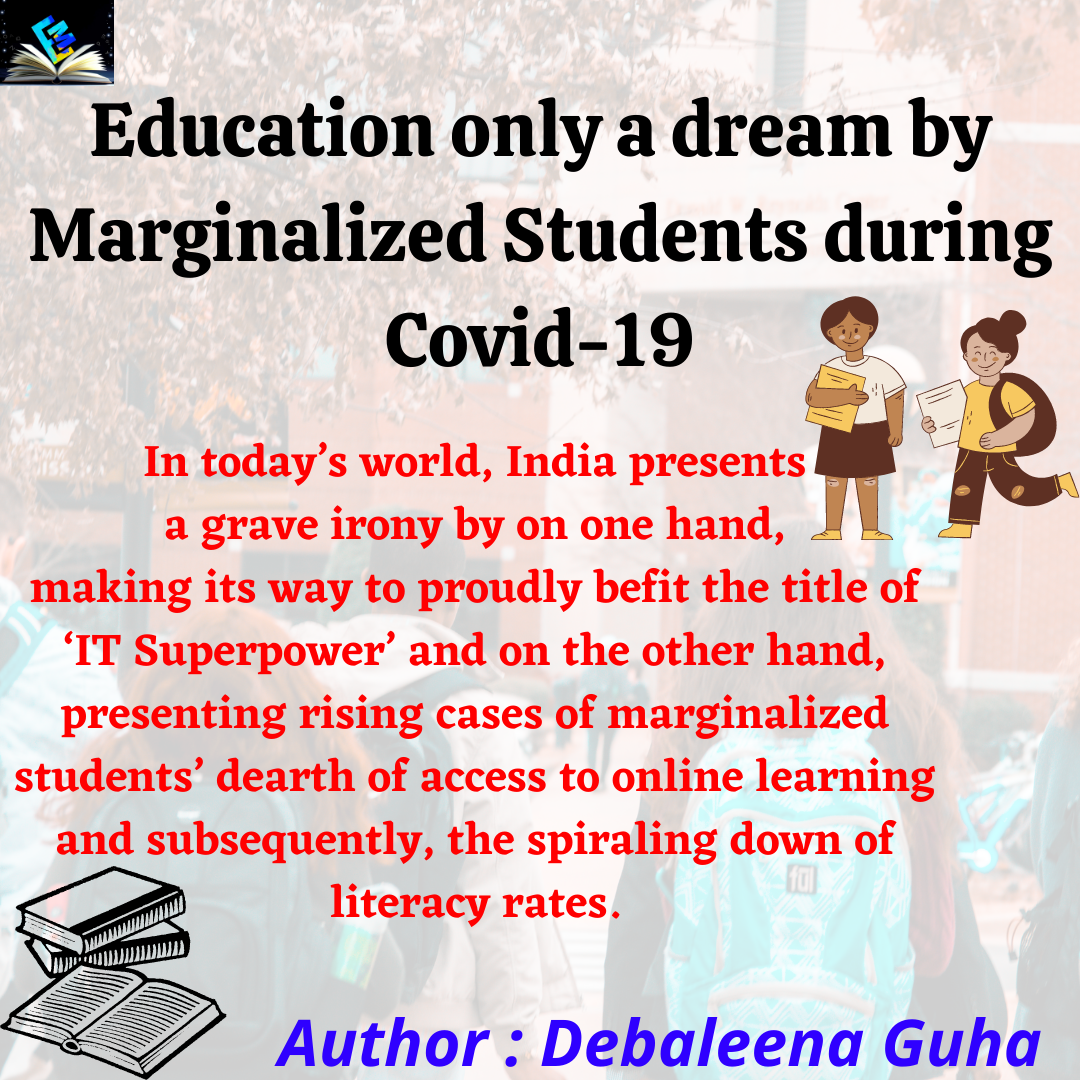
Education only a dream by Marginalized Students during Covid-19
Education is only a dream harboured by Marginalized Students in India during the Covid-19 Pandemic
Author : Debaleena Guha
The Covid-19 pandemic has revolutionized the teaching-learning pedagogy by strongly imbuing the Virtual Learning Environment (VLE) in students’ lives. In a country like India where only one out of four children have access to digital learning, this otherwise innovative medium has wreaked great havoc.
In today’s world, India presents a grave irony by on one hand, making its way to proudly befit the title of ‘IT Superpower’ and on the other hand, presenting rising cases of marginalized students’ dearth of access to online learning and subsequently, the spiraling down of literacy rates. This is evidenced by a recent UNICEF study stating that the shutting down of schools has posed an adverse effect on 247 million children enrolled in elementary and secondary schools.
The digital divide in India has never before been witnessed and experienced so starkly.
Despite the verdict given by the Kerala High Court in the Faheema Shirin R.K. vs State of Kerala (2019) case, establishing the right to access to the internet as a part of the right to education, the Indian government still has not undertaken any proper steps to stop this gross violation of the fundamental Right to Education of millions.
The New Education Policy-2020 launched by the NDA government has immensely stressed on smart classroom and digital education for all and clubbed the issues of education of women, SC/ST and minorities under a single frame, thereby proving its failure to tackle the multifarious problems and educational necessities of the marginalized students.
Plight of students belonging to the poor and backward castes’ community:-
The wealth gap in India can be cited as both a cause and a consequence of this rising crisis. According to the 2017-2018 National Sample Survey on Household Consumption on Education in India, only 23.8% households in India can access internet services and only 10.7% households have a computer. Those marginalized students, who could, with great difficulty, get hold of an electronic device, fall short of money to afford adequate data packages, necessary for continuous classes.
India has already been the unfortunate witness of few reported student suicide cases directly caused by lack of access to online classes.
Belonging to an extremely economically marginalized family, a fifteen-year old Dalit girl from the Malappuram district of Kerala committed suicide as she could not attend online classes and harboured the fear of lagging behind in her studies. She did not have a smartphone and her last resort, a television set was not functioning. Lack of access to a digital device as a result of extreme poverty took away the life of sixteen-year old Shabini Kumari Sau from the Howrah district of West Bengal.
These incidents are testimony to the failure of the government and the society, at large, to provide online education to all.
Daily wage earners, small businessmen and other low-income families have been badly hit by the pandemic. Students of these families, mainly belonging from the Scheduled Castes and Scheduled Tribes, have no other alternative but to serve as helping hands to earn extra money for running the household, thereby putting an end to their hopes to get educated and instead, leading to rise in child labour.
Students belonging to the elite classes in India have embraced online mode of learning with ease and at the same time, these poor students, with little or no access to online classes are being alienated from education which is making them intellectually paralysed. As adults, they will not be able to contribute to the country’s economy efficiently which will lead to an ever widening wealth gap for years to come.
The widening Gender Bias in Indian Education:-
In this context of analysing the access to education by students of marginalized communities, it is pertinent to throw light on the plight of girl students. In accordance with a Right To Education policy brief, the Covid-19 pandemic has created the possibility of ten million girls dropping out of secondary school. India is deeply embedded in patriarchy. With the country in lockdown, young girls are increasingly forced to engage in socially constructed, patriarchal, regressive gender roles such as household chores like cooking and laundry and sibling care, making it difficult for them to access online classes, even if they have the required resources. Education of boys has been prioritized over girls in many families who cannot afford it for every child. Steeped in poverty, illiteracy and patriarchy, many Indian families have high chances of coercing the girl children to drop out, rendering them susceptible to trafficking, early marriage and consequently, domestic abuse and early pregnancy. Though Covid-19 has significantly affected the learning of all students from marginalized communities, it is unfortunate to ascertain that this gender bias has given rise to an academic divide between boys and girls, proving that access to education in India is indeed gendered.
Exclusion of the most Marginalized Section:-
Along with facing many of the aforementioned problems, students with disabilities are countering unique challenges. Many of the Ed-tech applications and electronic devices lack inclusive features for students with disabilities such as mechanisms whereby text size can be increased catering to students with partial visual impairment, adaptive computer controls etc. Severe lack of well trained sign language interpreters and unavailability of essential subtitles are grave obstacles for students with hearing disabilities. In cases of students having intellectual disabilities, the serious deficiency of individual attention and two-way interaction has created severe hurdles. A majority of the disabled students entirely depend on their parents for access to online classes. Due to the extreme financial crisis raging the country, in many families, both of the parents are bound to resort to work, leaving their children with no scope to study.
Way forward:-
In the pandemic-stricken India of today, the focus on equitable access to education holds immense importance. An urgent need has arisen for the amendment of the Right To Education Act. The government should amend the RTE Act to make online learning an essential part of it and give equal stakes to the state governments so that they are obligated to provide students the required digital resources for smooth access to online classes.
In the present scenario, it is crucial to build a strong nexus between the government and the private sector in improving the technological infrastructure such as for establishing study rooms, learning centres etc in large numbers in remote areas backed by the facility of sound internet connectivity. In order for projects like the PM launched e-VIDYA initiative to work, the government needs to tie up with NGOs and CSR initiatives for allocating and distributing digital devices and free or very low cost internet services to students in need.
In order to address the deep-seated gender bias in education, time has come to adopt an efficient gender-sensitive approach. The government should extend financial aid to parents catering to the educational needs of girl children. The regressive gender norms followed by families and certain educational institutions should be strictly dispelled through strong laws. Further, the responsible citizenry should launch mass online campaigns with the aim of protecting the girl child’s right to education which can fuel the government and the NGOs to take adequate steps to support girl students with limited opportunities but big dreams.
Imbibing universal accessibility in the initial content making procedure rather than deprioritizing it as a mere supplementary process can largely benefit students with disabilities. There is a dire need in the rise of special educators who are trained in sign language interpretation and will be able to impart e-education efficiently, so steps should be taken in that direction. In the current digital mode of learning, pre-recorded videos with required subtitles are essential for students with hearing disabilities and for those with visual impairment, mechanisms should be implemented whereby they can easily access audio lectures.
To conclude, technology possesses the humongous potential to bridge the existing academic gaps and attain quality education for all. Ravaged by the Covid-19 pandemic, the need of the hour is to enhance its capabilities so as to make education more inclusive and ensure that it reaches even the remotest corners of the country. In this way, every student belonging from the marginalized communities will be able to exercise their right to education in this ‘new normal’ and we will head towards achieving education for all envisioned by the founding fathers of India.
FOR ANY QUERY MAIL US AT EDUMOUNDOFFICIAL@GMAIL.COM






